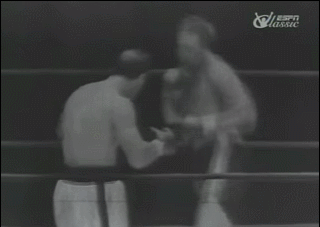Continuing on with part two...
Even when he was so resoundingly effective, though, Moore didn't rest on his laurels. Rightly so, because Durelle was still looking for the kill.

Here, Durelle throws out his jab, and then lunges in with a right hand after a moment of hesitation, the same combination that dropped Moore before. This time he's not so lucky.
Moore's poise is admirable in this exchange, which took place and the eleventh and, ultimately, final round of the fight. By this point in the fight, despite hitting the canvas four times, he's thoroughly figured Durelle's game, while Durelle hasn't even seen all of Moore's tricks yet. As the challenger flashes his jab, Moore thinks about countering with his own left hand. It's barely perceptible, the movement of his left only noticeably if you're really looking closely for it, but that's exactly what Durelle was doing. Thinking to catch Moore mid-punch, Durelle lunges into a right hand the moment he sees Moore about to punch. In doing so, however, he throws himself completely off balance. He can't be blamed for his zeal, as the right hand that dropped Moore in round one only landed as solidly as it did because Durelle was willing to fall in, extending the reach on his punch, but this time Moore is ready for it, and his own attempted punch hasn't put him out of position at all.
Adjusting to the new threat, Moore shoulder rolls the right hand to set up his counter, a perfectly placed cross to the chin. Unlike the shoulder roll of Floyd Mayweather Jr, with whom we tend to associate the technique, Moore prefers to execute his version from long range. Instead of parrying the opponent's punch with his left shoulder, Moore uses the rolling motion as more of an evasive maneuver, squaring his shoulders to present his centerline, and then suddenly turning, taking his opponent's target away. As you can see, it usually caused them to miss big.
Here's another example of Moore's unique shoulder rolling technique, from his ill-fated encounter with heavyweight legend Rocky Marciano.

Again, Moore places himself at a rather long distance from his opponent, forcing Marciano to badly overextend himself in his effort to land. As Rocky's looping right hand goes whistling by, Moore sticks the champion with a perfectly straight right of his own, its force multiplied by Marciano's forward momentum.
A Matter of Inches
As it turns out, Moore was relatively unconcerned with Marciano's notorious right. In the same Sports Illustrated interview quoted above, Moore claimed that Marciano's most fearsome punch was his left hook. If that was indeed the case, then Moore does a spectacular job of defending the one preceding the overhand above, simply by adjusting his right arm a few inches. As Marciano ducks down, Moore keeps his eyes on him and throws up the Lock, preparing for whatever wild punch might come next. Seeing the left hook, and it's a pretty short one by Marciano's standards, Moore changes the shape of his guard, lifting his right elbow to cover his jaw and catching the champ's left right on the point.
In part one we explored the history of Moore's iconic guard, and traced it back to the era of bare-knuckle boxing, in particular a trainer who was present at various times throughout Archie's career, a man by the name of Hiawatha Grey. If it was Grey who taught Moore the Lock, and I tend to think it was, then this makes perfect sense. Before their fight, Marciano described Moore as being "all gloves, arms, and elbows." A bare-knuckle boxer such as Grey would have made a formidable defense out of those arms and elbows, which present an unwelcome landing site for a fragile human fist. Even with gloves and wraps, Moore was exceptionally skilled at placing his arms in just the right position that his adversaries would connect directly with the point of his elbow, or the blade of his forearm.
Let's go back to the Durelle fight for a moment.

After eight rounds, Durelle had stunned Moore multiple times, but simply couldn't put him away. In this GIF, desperate for the right hand that had worked so well earlier, he stands right in front of Moore and tries to connect cleanly. Moore rolls under the first right hand, then raises his elbow, expecting a hook to the head or maybe an uppercut to follow. Instead, Durelle swings for the body, and Moore deftly lowers his elbow a few inches to cover his ribs. Durelle becomes so preoccupied with finding ways around Moore's defense that he forgets that Moore could stop defending and go on the attack at any moment. Moore promptly reminds him with a left hook, timed perfectly as Durelle cocks back his right hand and exposes his jaw.
Hidden Weapons
The most underrated aspect of Moore's game was his ability to hide his power punches, not merely disguising his intentions with feints, though he could fake with the best of them, but literally obstructing his punches from view. They say the punch that you don't see is the one that knocks you out, and much of Moore's success as a knockout puncher must be attributed to the unpredictability of his punches, all thanks to his crafty, sneaky style.

(Click to enlarge)
We've seen Archie slip inside the jab to load up a hook, but nothing about that was very unique to his system. Now we'll take a look at one of his most iconic attacks, a sneaky left hook thrown from the cover of his guard.

In this sequence, Moore battles a young Muhammad Ali, then known by the name Cassius Clay. Even at this early stage in his career, Clay possessed a vicious, unpredictable jab. It only took him four rounds to stop Moore in what would turn out to be the Old Mongoose's second-to-last fight, but Moore made a valiant effort until his old body started to let him down. Here, he reacts to a feint, expecting that stinging jab. Finding himself momentarily compromised, he stays low and covers to protect himself. Protected from the immediate threat of a left hook by his upraised right elbow, he decides to capitalize on his position, stepping forward and pulling back his left hand for a hook to the belt line of Clay.
Not merely a defense, that crossed right arm prevents Clay from seeing the action of Moore's left hand as he loads it up, and he stays in range too long to avoid it. Yesterday I compared this utilization of the Lock to sword and buckler fencing. Here, the comparison is particularly apt. Moore's right arm is his shield. Like a buckler, it is small and doesn't provide much defensive coverage, but it completely blocks Clay's line of sight while Moore positions his sword, the left hand. Clay has no indication of the trajectory or target of Moore's punch until it's already well on its way.
One more example of a hidden punch, this one from the second round of Moore vs Marciano.

Moore again capitalizes on Marciano's looping, hair-trigger right hand. Moving his upper body, he draws the punch out of his opponent so that he can counter. As Marciano unloads, Moore again executes his now-you-see-me shoulder roll, slipping just out of the way of the heavy punch. Having already dropped Marciano with a straight right in round one, Moore elects to throw an uppercut this time around. With his body turned to the right, Moore's left shoulder hides the right side of his body from Marciano's view. Watch as he keeps his arms glued to his body until he has fully turned his shoulder, at which point he quickly lowers his hand and pulls back his elbow for the uppercut. Marciano, wise to counters now, tries to bull his way through with a left hook, but Moore's uppercut, which he called a "defensive punch" catches the heavyweight champ leaning and halts his advance.
Moore had the keys to beat any style in his prime. Despite having to wait till the age of 36 to receive his first title shot, Moore ruled the light heavyweight division undisputed for nearly eight years, never losing his title to a challenger. One of the greatest pound-for-pound fighters of all time, Moore's success was built on the depth and adaptability of his system. The Lock, whatever its provenance, will stand forever as one of the most successful systems in the history of boxing.
For every question, an answer: that's how you solve a style.
The End


 Thanks:
Thanks:  Likes:
Likes:  Dislikes:
Dislikes: 








 Reply With Quote
Reply With Quote
Bookmarks